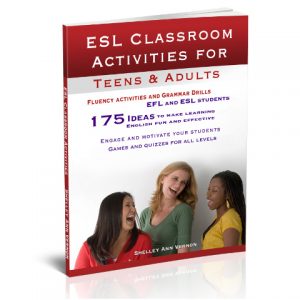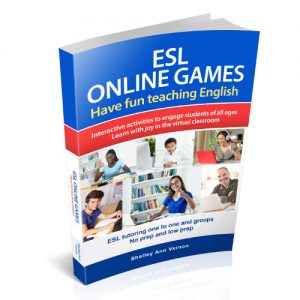A lesson plan for teaching Professions
Target language
Teaching professions vocabulary. What do you do? I’m a mechanic. What does he or she do? She or he is a vet. By all means, use this lesson plan for ‘they’ instead of he and she.
Choose eight professions
Start teaching professions by asking the class what they do and choosing eight jobs for everyone to learn. The danger of learning more than eight new words is that it’s too many, so no one remembers any of them! If you teach children, find out what their parents do and vote on six professions to learn together.
Listening activity
Teach the eight professions via a listening game where you repeat the words many times. The best way, even for adults, is to do a mime or gesture for each profession. For example, you say the job and the class mime it. This movement makes the word and the meaning memorable.
Big Freeze Game
To make teaching professions fun, play the Big Freeze. Have some students stand up and mime the professions in small groups. Then, you say FREEZE, and the students must freeze in their position. Point at one of the students and ask, “What is his (or her) profession?” The class guess the mime, which may or may not be easy, depending on the student’s position. Once you have demonstrated this a couple of times, make three teams.


One team is the students who act, while the other two teams watch and guess the professions. Rotate around, so each team has a go acting and freezing while the other teams score points for guessing the profession first.
Thoughts and tips
Have students mime in groups or together because it helps the shy ones feel less awkward.
If you find the same students jump in and answer before anyone else has a chance, then put all those quick students together in the same team.
You might be thinking that this sounds a bit childish, but the thing is that it works for learning vocabulary and remembering it. However, it’s more effective than just writing up the words on the board for students to copy down.
Teaching professions writing activity
Next, write up the words on the board while students copy them down since this can help students memorize them. Then you can write up some anagrams of the terms and let students call out what they are. For example, “cotdor” – doctor.
Teaching professions: ‘What do you do?’
It is helpful to work on the question “What do you do?” or “What do you do for a living?” since, typically, that is how we ask people their profession in conversation. We don’t ask, “What is your profession?” However, we might use that question format in a formal interview, but not in everyday conversation.
-
Games
Games and Activities for Teens and Adults
Rated 5.00 out of 5€19.97Original price was: €19.97.€15.33Current price is: €15.33. Add to cart
Passing game
For this, first, drill the question with the whole class repeating it three times after you. Then take a piece of paper with the profession written on it, or use a picture. Show the card. “Doctor.” Hand the card to a student and ask: “What do you do?” The person answers you with “I’m a doctor” and takes the card. Demonstrate this a couple of times. Now the student passes the card to the student next door, asking, “What do you do?” The other student takes the card and answers, “I’m a doctor.”
Repeat with the next student along with the whole class watching. Now you are sure everyone knows what to do, so that card goes on its way around the class with everyone practising the question and answer. In the meantime, you give the first student a different profession card to pass around, asking, “What do you do?” ‘and answering “I’m a mechanic” (or whatever is on the card.)
Once students are busy passing the cards and practising, clap to stop the activity – all those students with cards stand up and do a forfeit, like answering a general knowledge question, or, for kids, do a silly dance or something fun.
After that, you can have the class draw a grid with NAME and PROFESSION, and students go around asking the others, “What’s your name?'” and “What do you do?” and fill in the chart.
Group activity
Then ask students to get into groups of similar professions, but don’t tell them what they should be – leave it up to the students. Students group together in different parts of the room, so you might have service jobs in one part of the room, people who work with their hands elsewhere, creative jobs, sales jobs, and so on. Then compare notes and see why students thought their professions were related. You might have to use L1 for this if you have complete beginners.
Fill in Drill
The game is in my teen and adult ESL games book, and you can read how to play it here: Fill in Drill. This activity is great for using professions, the question and answer, and general English for fluency.
First, write out some simple English appropriate for the level of your class.
An example of a text you could use would be this:
“Hello there, I’m Paul. What’s your name?”
“Hello, I’m Jane. Nice to meet you.”
“What do you do for a living?”
“I’m a surgeon” (insert one of the professions you have been using).
“Wow, that’s interesting. Do you like it?”
“I like it apart from the fact that you have to cut people open.” (put in something relevant to the profession)
“Oh, I see. Mmmm that could be difficult.”
“What do you do?”
“I’m a _____________”
That should be long enough since the students will memorize the whole dialogue during the game.
Finally, you can ask them to write it all out from memory, swap papers, and check each other’s spelling.
Introduce the third person
Now you have worked on this; it’s time to introduce the third person question form: What does he do? What does she do? Get the class to ask the question with you. Point to a pic of a man doing a job. (Use my professions flashcard set, which can be purchased here as downloads.
Alternatively, have students draw pictures or find some in magazines or your textbook.)
So, ask, ‘What does he do?’ Choose one student to answer. Now switch to a female for, ‘What does she do?’ and have students respond. Jump back and forwards between men and women, so students get used to switching from he to she.
Play with rhythms
Say the question in different rhythms, pausing on another word each time, and have students copy your rhythm. Speed it up, slow it down. That’s an excellent excuse to have students repeat the sentence several times but in a varied way.
Music
If you are musically inclined, this activity should make some students smile. Demonstrate by singing up an arpeggio ‘What does he dooooooooo?’ Next, have all students sing that with you, and then, have some hold the base note on ‘What.’ Others hold the remaining notes in the chord in turn. Then point at a picture, and the class answers, ‘he’s a gardener’ or whatever the profession is. If you have kids, this will take some training. But once your students know how to hold a chord as a class, you’ll be able to use this musical interlude for any sentences.
Hand slap rapid reaction game
If your students are fun-loving, play the hand slap game from 176 ESL Games for Children. Kids love this and some adults will, but not all. Students stand opposite each other. Each one places their right hand out in front. Student A’s hand is on top. Now student A asks, ‘What does she do?’ Student B replies with any profession that comes to mind, ‘She’s a doctor.’ And SLAP, student B tries to slap student A’s hand before student A can move it out the way. Then, swap over.
-
Games
ESL Games book for primary & middle school children
Rated 5.00 out of 5€19.97Original price was: €19.97.€15.33Current price is: €15.33. Add to cart
From ESL Activities for Teens and Adults: Play the Grammar Auction game using all forms of the question and answer, some correct, some with errors. Next, you could play Typhoon or Blow Your House Down using famous people your students are likely to know. For example, the people could be presidents, singers, actors, chefs, architects, politicians and people in the news, people on TV from soaps or shows, etc. However, if you want to work on the past simple form and ask, “What did she do?” then use famous people who are dead. Albert Einstein: What did he do? He was a scientist.
Let me know how it goes and what ideas you try.
Shelley Ann Vernon
Teaching English Games
-
Games
Games and Activities for Teens and Adults
Rated 5.00 out of 5€19.97Original price was: €19.97.€15.33Current price is: €15.33. Add to cart




1 thought on “Teaching professions and What do you do?”
Thank you for your great ideas.